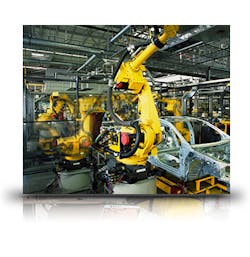Telcos to Play More Prominent Role in Manufacturing
The advent of consumer technologies such as smartphones, iPads, and even Google Glass, into the manufacturing space has launched a dramatic transformation of what we commonly think of as industrial technologies. Underlying the use of all these technologies in both the industrial and consumer space is, of course, the Internet. So by doing a simple connect-the-dots exercise, it’s not all the surprising to see the telcos, which control all the networks enabling various forms of Internet connectivity, becoming bigger players in industrial technology discussions
One of the first places we’re seeing the telcos position themselves is in the area of remote monitoring and maintenance. Deutsche Telekom, for example, offers a Remote Equipment Management product which offers “a comprehensive solution that any qualified electrician can set up,” says Markus Breitbach, vice president of global sales and marketing, Deutsche Telekom’s M2M Competence Center. “It uses a mobile network-based controller to ensure that data and instructions from and for the machine are transmitted, received, and passed on. During setup the electrician connects the controller’s digital inputs and outputs and its analog inputs with the machine’s. He can then configure the operating parameters with the software built into the controller.”
Once connected to the mobile network, the controller can then communicate with terminal devices, such as PCs, tablets and smartphones, or a server. The management software uses authentication to ensure that only authorized users can start and stop processes or adjust settings. It also provides configuration options. “The alarm function, for example, alerts maintenance personnel automatically by email or text message if a specified limit is exceeded or readings fall below it,” says Breitbach. “Field service can then be sent out without delay to rectify the error.”
Of course, Deutsche Telekom is not the only telco focusing on the industrial space. Sprint also offers services targeted at manufacturers—even to the point of providing specific M2M (machine-to-machine) services for asset management and remote monitoring as Deutsche Telekom does. The Automation Conference will feature a keynote presentation by John Ruffing of Sprint. In his presentation, Ruffing will explain the business value of delivering live data from your business, your industrial processes, and even your products to the manufacturing workforce. He will also discuss best practices for deploying mobile tablets in harsh environments, including how to ruggedize, manage and secure mobile devices and data.
Learn more about and register for The Automation Conference.
Telcos see an opportunity in manufacturing, Breitbach points out, because mobile network-based connections are less expensive and provide faster transmission rates than the serial interfaces traditionally used in manufacturing. Plus the mobile networks eliminate the cord required for serial interface connections. Deutsche Telekom’s method for establishing mobile connections is to connect a terminal to a machine’s serial port to establish a secure connection via an encrypted tunnel to a server in the company’s network or the cloud-based service of an authorized service provider.
“Authenticated users can then access the machine from anywhere in the world,” Breitbach says. “The serial interface is extended into a corporate network. Maintenance services then access the machine with their usual software.”
Until recently, it was expensive to connect M2M networks in ways such as those offered by Deutsche Telekom or Sprint for remote monitoring or proactive maintenance. “In the worst case, users had to sign separate contracts with hardware and software manufacturers and mobile network operators,” says Breitbach. “Today, it is easier since telcos and global IT service providers bundle all of the components and competences required. They aim to offer companies comprehensive single-source solutions. Without costly capital expenditure the entire solution can be booked per machine for a fixed price.”

